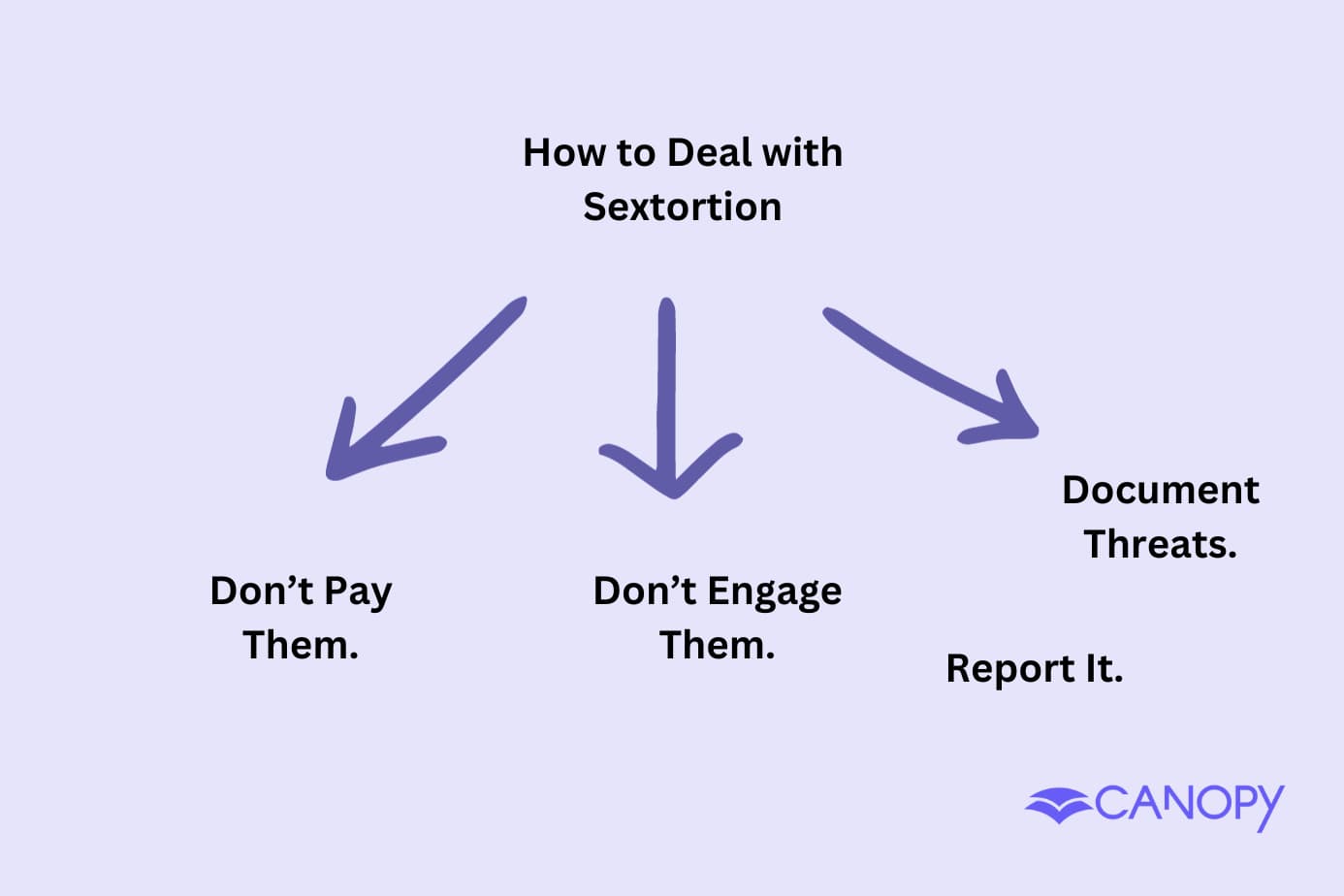In 2022, the FBI received 7,000 reports related to the online sextortion of minors. At least 12 of those ended in suicide.
How many victims of sextortion don’t come forward? How many more are so tormented by their sextortionists that they take their own life?
Even one instance of sextortion, reported or not, is one too many. So the question is: how do we stop our children from being victims of this crime?
One way is to learn what to look out for.
9+ Methods of Sextortion – Scams to be Aware of
Let’s look at nine common sextortion examples, how they occur, and how you can avoid these scams altogether.
Every example comes with an avoidance tip which you and your child should follow.
1. Catfishing sextortion scams
Catfishing is when someone creates a fake online identity to deceive others. They’ll often pose as someone young and attractive and they use someone else’s photos to convince you that they’re real.
In sextortion cases, the catfisher might pretend to be a potential romantic partner.
They’ll take the time to build trust with you and at some point they’ll either ask you to send naked photos of yourself. Often, they’ll send you photos first.
Once you’ve sent the nude images or video, the sextortionist will threaten to expose you unless they’re paid or given additional explicit content.
Avoidance tip: Be wary of strangers online and teach your child to be too.
If someone seems too good to be true, they probably are. You can use reverse image searches to check profile photos and keep in mind how sophisticated technology has become in creating fake photos.
Make sure your child knows what to look out for in a fake profile and that they should come to you if a stranger starts messaging them.
2. Social media (Instagram, Snapchat, Facebook) sextortion scams
Cybertip.ca, a tipline for victims of sextortions, found that 84% of sextortion incidents reported to them had occurred on Instagram or Snapchat.
And it’s no wonder when Instagram, Snapchat, Facebook and even TikTok give sextortionists access to millions of potential targets.
They can easily contact people they otherwise wouldn’t know, build ‘relationships’ with them, and then abuse that relationship through extortion.
Sextortionists on social media might send unsolicited explicit content and then demand payment to avoid sharing it with your contacts. Or they could manipulate you into sharing intimate photos and then use them against you.
Avoidance tip: Adjust your and your child’s privacy settings.
You, and they, should only accept friend requests from people you know and trust. Be cautious about sharing personal information or photos with strangers.
3. Hacked webcam sextortion scams
Did you know that your webcam can be hacked? Think of all the things people do in front of their computers or the conversations they have with others on a video call.
Hackers can take an innocent moment like someone getting dressed post-shower, record it, and use it against them. They might also record more compromising moments such as masturbation or video sex with a partner.
These sextortionists will then send the recording to their target and make their demands known.
Avoidance tip: Regularly update your software and use strong, unique passwords.
Consider covering your webcam when not in use and be cautious about clicking on unknown links that could install malware. Consider a family rule where computers are only to be used in family spaces such as the living room and never in bedrooms.
Related Read: How to Deal with Sextortion (Steps for Parents)
4. Hacked account sextortion scams
In this scenario, a hacker gains access to your online accounts, finds compromising information or photos, and then threatens to expose them.
Hunter Moore famously had a revenge porn site where his team would hack into girl’s email accounts, steal their nude photos, and then post them on the internet. While not exactly sextortion, this shows the scary reality that our private information can be accessed by horrible people.
Avoidance tip: Use two-factor authentication for your accounts.
Regularly change passwords and avoid using the same password across multiple platforms. Most of all, avoid taking naked photos that someone else could steal. If you want to ensure your child doesn’t take naked photos of themselves, download Canopy.
Canopy’s sexting prevention features alerts you when a nude photo is taken or received on your child’s device.
Related Read: The Dangers of Sexting
5. Email sextortion scams
Sextortionist might try their luck by sending threatening emails, claiming to have naked photos or videos of you that they took from your computer. They might pretend they’re a hacker, as in our two examples above.
In the email, they’ll demand payment, often in cryptocurrency, to keep it private.
But unless they sent real images that you know to be of yourself, they’re probably lying.
Avoidance tip: Don’t click on suspicious links or download unknown attachments. Use email filters to catch phishing attempts. Make sure your child knows not to respond to phishing emails and that if they ever receive a threat, to tell you immediately.
6. Sextortion from someone you know (ex or current significant other)
Unfortunately, there are times when those we once were intimate with turn sour and threaten to share explicit photos or videos taken during the relationship.
There are also times when an abusive current partner threatens to send your nude photos around unless you send them more.
In fact, one study of adolescent sextortion victims from 2018 showed that nearly 60% of respondents knew the perpetrators in person, and that they were often current or former romantic partners.
Avoidance tip: The best way to prevent this from happening to you is to never send an explicit photo or video to anyone, no matter how much you trust them.
As your child gets older and begins to have relationships, you want to make sure they’re doing so in a safe manner. They need to know that being pressured to sext is never okay.
With that said, the best way to make sure your child doesn’t send nude photos is to install Canopy on their device with its sexting prevention feature.
7. Sextortion from someone you know (bully or ex-friend)
A falling out with a friend or being the target of a bully can lead to threats of exposing embarrassing information or photos.
Silly in-the-moment photos where your child ‘flashes’ a friend could become leverage against them if the relationship goes south.
Avoidance tip: Tell your child to be cautious about what they share, even with friends. If they’re being bullied, they should feel comfortable coming to you for help.
Related Read: How to Prevent Cyberbullying (11 Tips)
8. Reverse sextortion scams (something used against you to get you to send nudes)
In this sextortion example, the sextortionist has your personal details, like bank information or passwords to important accounts. They will then threaten to release this information or steal from you unless you send them explicit content.
What they do with the content can range from using it on a pornography site to keeping it for themselves.
Avoidance tip: Protect your personal information. Use strong passwords and be wary of sharing sensitive details, even in seemingly innocuous online quizzes or surveys.
9. Deep fake porn sextortion scams
Advanced AI can create realistic but entirely fake content.
Sextortionists might use your social media photos to generate explicit images or videos that appear to be you.
They’ll then send these images to you and threaten exposure unless you give in to their demands. Even if you know the photos to be real, they’ll convince you that others won’t.
Most often, they rely on the shame you’ll feel should they release the photos to people you know.
Avoidance tip: Limit the photos you share publicly and use privacy settings to restrict who can view your content. When it comes to your children, you should consider banning social media access.
With Canopy, you can restrict access to apps and websites you don’t want your child to use. This will ensure their online presence isn’t taken advantage of.
Real Sextortion Examples & Cases
Sextortion has been all too real for many people. Sometimes seeing how they played out can help us know what to look out for in our own lives.
So let’s look at these 4 real-life cases of sextortion:
Gavin Guffey, a 17-year-old boy from Rock Hill, South Carolina took his own life after sextortionists had pretended to be a young girl online.
They convinced him to send nude photos and once they had them they started to demand money. Gavin sent them all the money in his bank account but it wasn’t enough.
The sextortionists continued to threaten exposure and overwhelmed by the shame and fear, Gavin committed suicide. After his death, the scammers began sending messages to his family—again demanding money and cruelly mocking Gavin’s death.
Lucas Michael Chansler, a 31-year-old man at the time of his conviction, sextorted 350 girls across the US, Canada, and UK.
He pretended to be a teenage boy online and convinced his female victims (all between the ages of 13 and 18) to send nude pictures. He was known to follow through on his threats, distributing the nude photos if the girls didn’t comply. He told police that he targeted young girls because older women were too smart to fall for the scam. Lucas was sentenced to prison for 105 years.
In 2022, an unidentified Instagram sextortionist traumatized 30 boys after tricking them into sending nude photos.
One victim paid as much as $1500 in gift cards before committing suicide.
The sextortionist even hacked into at least two of the boy’s Instagram accounts as leverage and as a way to threaten them further.
Bryan Asrary pretended to be Justin Bieber online and threatened a 9-year-old girl with harm unless she sent him explicit photos.
The young girl didn’t come forward until she was 11 years old and police believe there were more victims.
Asrary targeted the girl on Instagram pretending to be a friend of Justin Bieber’s, capable of putting her in touch with the celebrity if she downloaded another app called Kik.
Once on the app, Asrary pretended to be Justin Bieber and convinced her to send nude photos of herself. Two years later, Asrary threatened exposure of the girl’s photos unless she provided more.
Protect your child from sextortion with Canopy
Sextortion of minors is on the rise, according to the FBI.
Being aware of this fact and knowing the most prevalent forms of sextortion is only the beginning.
As parents, we need to be more proactive. And at Canopy we’ve worked hard to provide you the means to do so.
Canopy is a parental control app that comes with sexting prevention. This feature can detect when your child takes a nude photo or if they are sent one from someone else. It then alerts you to the activity.
This means you can stop sextortion from happening whether it’s a stranger online or a boyfriend or girlfriend they think they can trust.
And with the ability to block access to unsafe apps and websites where sextortionists pick their targets from, you can rest easy that your child won’t be among them.
→ Protect your child from sextortion—get started with a free trial of Canopy. ←
Source(s):





